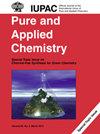The effect of chemical modification using citraconic anhydride on the stability of α-amylase from Aspergillus fumigatus
IF 2
4区 化学
Q3 CHEMISTRY, MULTIDISCIPLINARY
引用次数: 0
Abstract
The purpose of this research is to improve the stability of α-amylase from使用柠檬酸酐进行化学修饰对曲霉α-淀粉酶稳定性的影响
本研究的目的是通过柠康酸酐的化学修饰来提高烟曲霉α-淀粉酶的稳定性。α-淀粉酶采用离心技术分离,然后用硫酸铵盐沉淀和透析进行纯化。实验结果表明,纯化后的α-淀粉酶的稳定性是粗提取物的 13.41 倍。最适温度也有明显提高,原生α-淀粉酶的最适温度为 50 °C,而改良α-淀粉酶的最适温度为 60 °C。同样,半衰期也明显延长,原生酶的半衰期为 38.72 分钟,而改性α-淀粉酶的半衰期为 256.67-330.00 分钟,这取决于所用柠檬酸酐的体积。改性还导致自由能值(ΔG i)从原生酶的 104.348 增加到改性α-淀粉酶的 109.585-110.281 kJ mol-1,表明改性α-淀粉酶比原生α-淀粉酶更硬。这项研究的结果表明,柠檬酸酐是一种非常有前途的改性剂,可以提高从烟曲霉中分离出来的α-淀粉酶的稳定性和性能。这项研究的结果也为柠檬酸酐在其他酶中的应用提供了机会。
本文章由计算机程序翻译,如有差异,请以英文原文为准。
求助全文
约1分钟内获得全文
求助全文
来源期刊

Pure and Applied Chemistry
化学-化学综合
CiteScore
4.00
自引率
0.00%
发文量
60
审稿时长
3-8 weeks
期刊介绍:
Pure and Applied Chemistry is the official monthly Journal of IUPAC, with responsibility for publishing works arising from those international scientific events and projects that are sponsored and undertaken by the Union. The policy is to publish highly topical and credible works at the forefront of all aspects of pure and applied chemistry, and the attendant goal is to promote widespread acceptance of the Journal as an authoritative and indispensable holding in academic and institutional libraries.
 求助内容:
求助内容: 应助结果提醒方式:
应助结果提醒方式:


